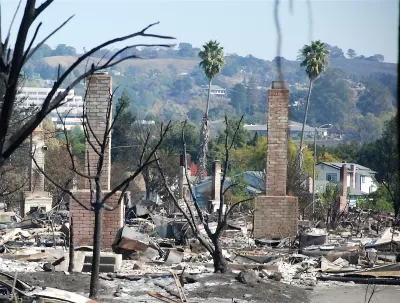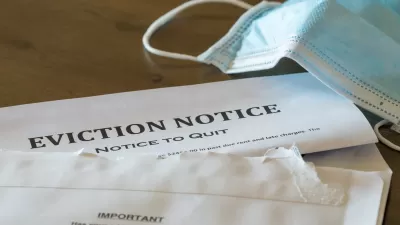Low-income renters face an increased risk of eviction after a natural disaster. Most cities and states don’t offer any protection.

A Sonoma County, California ordinance passed last month bars landlords from evicting tenants during weather disasters and other declared emergencies. The first-in-the-nation “disaster-triggered” moratorium aims to prevent waves of evictions similar to those that impacted residents in Florida during the 2021 hurricane season. The Sonoma ordinance is the result of activism from the region’s large agricultural worker community, who suffered after 2017’s Tubbs Fire.
In a Bloomberg CityLab article, Patrick Sisson explains how natural disasters lead to evictions. “Lack of internet access can cut off the ability to pay rent online, and those who evacuated can’t just drop off rent checks. Jobs are upended and schools close, putting childcare strains on working parents. And damage to homes and workplaces continue to exact a lingering economic toll on the afflicted area long after emergency response is completed.” Compounding the problem, a study found that rents go up by 4 percent to 6 percent in impacted areas, and evictions rise sharply.
Supporters of the Sonoma law hope it can be a model for other communities, particularly in vulnerable areas like south Texas and Florida.
FULL STORY: Should Evictions Be Banned After Hurricanes and Climate Disasters?

Trump Administration Could Effectively End Housing Voucher Program
Federal officials are eyeing major cuts to the Section 8 program that helps millions of low-income households pay rent.

Planetizen Federal Action Tracker
A weekly monitor of how Trump’s orders and actions are impacting planners and planning in America.

Ken Jennings Launches Transit Web Series
The Jeopardy champ wants you to ride public transit.

Sacramento Plans ‘Quick-Build’ Road Safety Projects
The city wants to accelerate small-scale safety improvements that use low-cost equipment to make an impact at dangerous intersections.

How Project Connect Would Change ‘The Drag’
A popular — and sometimes deadly — Austin road will exchange car lanes for light rail.

Milwaukee Road to Get Complete Streets Upgrades
The city will reduce vehicle lanes and build a protected multi-use trail including bioswales and other water retention features on its ‘secret highway.’
Urban Design for Planners 1: Software Tools
This six-course series explores essential urban design concepts using open source software and equips planners with the tools they need to participate fully in the urban design process.
Planning for Universal Design
Learn the tools for implementing Universal Design in planning regulations.
Ada County Highway District
Clanton & Associates, Inc.
Jessamine County Fiscal Court
Institute for Housing and Urban Development Studies (IHS)
City of Grandview
Harvard GSD Executive Education
Toledo-Lucas County Plan Commissions
Salt Lake City
NYU Wagner Graduate School of Public Service





























